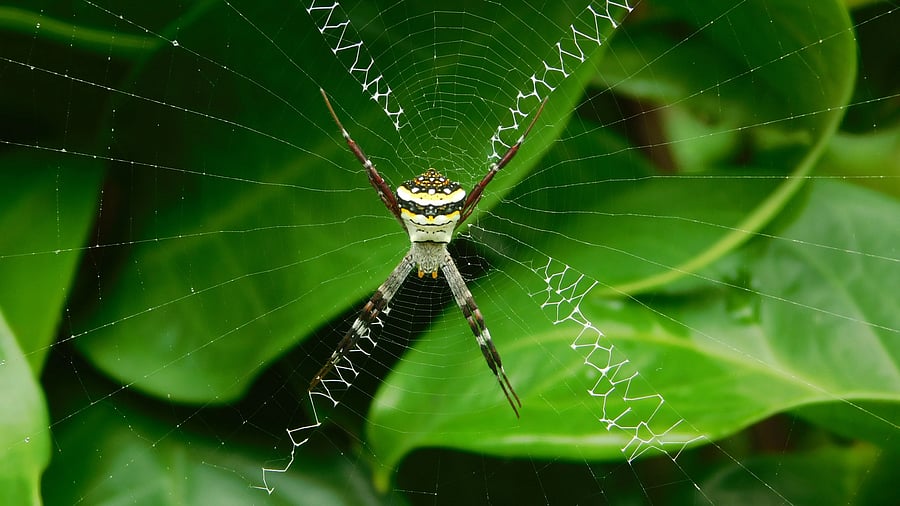
Credit: Special Arrangement
A mysterious predator prowls around Navilu Kaadu. The ruthless hunter lays an intricate trap to snare prey. The creature cannibalises even its own kind and marks its presence with distinct zigzag patterns on its silken abode — the signature spider, also known as the writing spider (Argiope anasuja).
We often see signature spiders on the front porch of our cottage. They scrawl bold autographs above our main door, mooring their web between the security camera and the metal tube supporting the alamanda vine, or across the scaffolding holding up the awning, and even amid foliage around the farm.
The genus Argiope consists of several species of signature spiders, falling under the family Araneidae, a group that comprises orb-weaving spiders that spin radial webs. These spiders get their names from the designer webs that the females weave for themselves, with bold zigzag patterns called stebilimenta that resemble signature flourishes. The spiders weave up to four stebilimenta on their spiral webs.
The female stations herself upside down with her pentagon-shaped abdomen positioned at the centre of the web, and her long and sturdy limbs resting in pairs, marking an X on the web while she awaits her meal to entangle itself in her trap.
The spider’s patterned web appears to serve more purposes than one. It could be a warning to hungry predators to keep off a signature spider diet, or a way to prevent birds from flying through the web. The stebilimenta could also be reflecting ultraviolet light to lure insects for the hungry spider to feed on. Signature spiders can devour prey larger than their own body size.
Like most spider species, signature spiders display sexual dimorphism — scientific parlance for anatomical or bodily differences between genders. The gents are tiny and mostly unmarked. They are a little more than a quarter the size of the ladies who span 8 to 12 mm or more. The females wear vivid yellow, rust, black or white bands on their abdomens.
Male signature spiders weave companion webs alongside the female’s web. In a macabre mating ritual, the female snacks on the pint-sized male after mating. Scientists theorise that the female derives nutrition from eating her mate to better her chances of birthing sturdy progeny. It could also be that the much larger female spider’s predatory instincts are triggered by the vibration of the web when the diminutive male approaches her.
In some species of spiders, the males willingly offer themselves up as prey during mating, in an ultimate sacrifice to sire healthy offspring. Nimble-footed males in certain spider species scurry to safety soon after mating, to escape their lady love’s fatal bite.
Once mated, the female lays eggs on the companion web and bundles them all up in a cosy egg sac. A single egg sac can contain up to 1400 eggs. After hatching, the spiderlings remain within the egg sac until spring. The young spiders inherit the mum’s cannibalistic instincts, and the siblings proceed to prey on each other within the egg sac until they finally break out of the sac. Speak of twisted family dynamics!
On emerging, the spiderlings position themselves on lofty perches, hoist their backsides in the air, and release a cloud of gossamer threads. These downy strings are protein fibres secreted in specialised glands called spinnerets in their abdomens.
The spiderlings swing from their perch to ride Earth’s invisible electric field, in a behaviour known as ballooning. The merry little spiderlings are known to journey between a couple of metres to hundreds of kilometres on their silken balloons.
As the spiderlings develop and gain in size, they moult a bunch of times, shedding their old exoskeletons until they reach adulthood, which could range between a few weeks to a few months, depending on the species.
If you are an arachnophobe like my older teen, rest assured that the signature spider is harmless to humans. They may bite if threatened, but the bite isn’t unlike a bee sting, other than for those with venom allergies.
A habitat that hosts signature spiders signifies a balanced ecosystem with a healthy insect population for the spiders to prey on. The next time you are in a park or in your garden, look around, and you may spot a signature spider stationed on its autographed web.
Rooting For Nature is a monthly column on an off-kilter urban family’s trysts with nature on a natural farm. The author runs Green Goobé, a sustainable venture committed to a greener, cleaner planet. Reach her at bluejaydiaries@gmail.com or @ramyacoushik on Instagram.